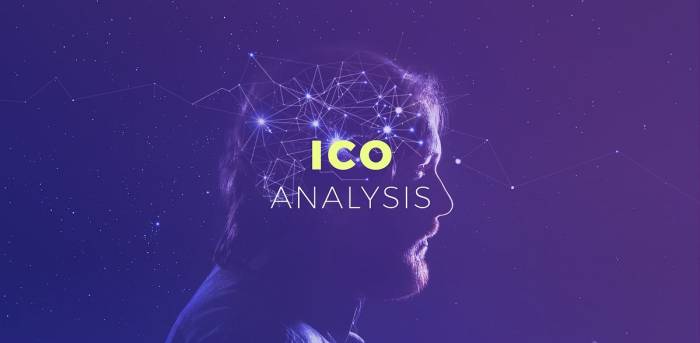ICO analysis is crucial for investors looking to navigate the cryptocurrency landscape. From understanding the basics to evaluating risks and opportunities, this overview delves into the essential aspects of ICO projects.
Exploring the factors that drive successful ICOs and the legal challenges they face, this guide equips readers with valuable insights to make informed investment decisions.
Introduction to ICOs
![]()
Initial Coin Offering (ICO) is a fundraising method in the cryptocurrency industry where new projects sell their underlying crypto tokens in exchange for funding. This allows them to raise capital to support their project development and operations.
ICOs differ from traditional fundraising methods like IPOs (Initial Public Offerings) as they are open to a global audience, have lower entry barriers, and offer more flexibility to both investors and project creators.
Advantages and Disadvantages of ICOs
- Advantages:
1. Access to global investors without geographical restrictions.
2. Lower entry barriers for both investors and project creators.
3. Flexibility in terms of investment amounts and token liquidity.
- Disadvantages:
1. Lack of regulatory oversight leading to potential scams and frauds.
2. High volatility and risk associated with investing in new projects.
3. Uncertain legal status in many jurisdictions creating regulatory challenges.
Factors to Consider in ICO Analysis
When analyzing an ICO, investors should consider several key factors to make informed decisions and mitigate risks. These factors include the team behind the project, the technology and use case, token economics, market demand, and regulatory compliance.
Team Behind the Project
The team behind an ICO plays a crucial role in its success. Investors should research the team members’ backgrounds, experience, and track record in the industry. A strong and experienced team increases the likelihood of the project’s success.
Technology and Use Case
The technology and use case of the project are essential factors to consider. Investors should assess the uniqueness and feasibility of the project’s technology, as well as its real-world application. Projects with innovative technology and a clear use case are more likely to attract investors.
Token Economics
Token economics refer to the distribution, supply, and utility of the project’s tokens. Investors should analyze the token distribution model, token supply, and how the tokens will be used within the ecosystem. Projects with a well-thought-out token economics model are more likely to succeed.
Market Demand
Understanding the market demand for the project’s product or service is crucial. Investors should assess the potential market size, competition, and demand for the project’s solution. Projects that address a significant market need and have a clear target audience are more likely to gain traction.
Regulatory Compliance
Regulatory compliance is a critical factor in ICO analysis. Investors should ensure that the project complies with relevant regulations and legal requirements in the jurisdictions where it operates. Projects that prioritize regulatory compliance are less likely to face legal issues in the future.
Examples of successful ICO projects that stood out include Ethereum, which introduced smart contracts and decentralized applications, and Binance Coin, which powers the Binance exchange and offers various use cases within the ecosystem. These projects had strong teams, innovative technology, clear token economics, high market demand, and compliance with regulations.
Investing in ICOs comes with risks, including regulatory uncertainty, market volatility, and project failure. To mitigate these risks, investors should conduct thorough research, diversify their investments, only invest what they can afford to lose, and stay updated on regulatory developments in the crypto space.
ICO Token Economics: ICO Analysis
Investing in an Initial Coin Offering (ICO) involves understanding the token economics of the project, which plays a crucial role in determining its success. Token economics refers to the design and distribution of the tokens that will be used within the project’s ecosystem. This includes factors such as token supply, allocation, utility, and demand.
Token Distribution Models
When it comes to token distribution models in ICOs, there are various approaches that projects can take. One common model is the percentage-based allocation, where tokens are distributed based on a set percentage for different purposes such as development, marketing, team, and community incentives. Another model is the fixed-price sale, where tokens are sold at a predetermined price to investors. The Dutch auction model is also popular, where the token price decreases over time until all tokens are sold. Each model has its own impact on the project’s success, depending on factors like investor interest, fundraising goals, and community engagement.
Influence on Long-Term Value
The tokenomics of a project can significantly influence its long-term value and sustainability. A well-designed token economy with clear utility and scarcity can create demand for the token, driving up its value over time. On the other hand, a poorly designed tokenomics model with excessive token supply or lack of utility can lead to inflation and devaluation of the token. Projects that focus on creating a strong ecosystem where the token plays a vital role in accessing services or products are more likely to succeed in the long run. Investors look for projects with sound token economics that demonstrate a clear path to value appreciation and sustainability.
Legal and Regulatory Considerations

In the world of ICOs, legal and regulatory considerations play a crucial role in shaping the landscape for projects looking to raise funds through token sales. Navigating the complex web of regulations in different jurisdictions can be a daunting task for ICOs, as they must ensure compliance to avoid legal repercussions.
Challenges Faced by ICO Projects
- Uncertainty in Regulatory Frameworks: ICOs often operate in a gray area, with regulations varying significantly from country to country. This lack of clarity can make it challenging for projects to understand what is expected of them.
- Legal Compliance: ICOs must adhere to anti-money laundering (AML) and know your customer (KYC) regulations to prevent illicit activities such as money laundering and terrorist financing.
- Securities Laws: Determining whether a token constitutes a security under relevant securities laws is a crucial consideration for ICO projects, as failure to comply can lead to severe consequences.
Impact of Regulations on the ICO Ecosystem
- Increased Scrutiny: Regulators around the world have started cracking down on ICOs that violate securities laws or engage in fraudulent activities. This has led to a more cautious approach from investors and projects alike.
- Market Fragmentation: Divergent regulatory approaches in different jurisdictions have resulted in market fragmentation, making it challenging for ICOs to operate on a global scale.
Examples of Regulatory Actions Against ICOs, ICO analysis
-
The SEC’s action against the ICO of Telegram’s TON project in 2019, which resulted in the project returning $1.2 billion to investors and paying a $18.5 million fine for violating securities laws.
-
The People’s Bank of China’s ban on ICOs in 2017, citing concerns over financial stability and investor protection, effectively shutting down the ICO market in the country.
